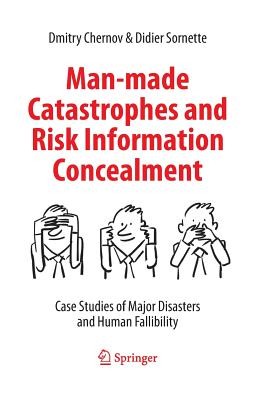
- We will send in 10–14 business days.
- Author: Dmitry Chernov
- Publisher: Springer
- ISBN-10: 3319370987
- ISBN-13: 9783319370989
- Format: 15.6 x 23.4 x 1.9 cm, minkšti viršeliai
- Language: English
- SAVE -10% with code: EXTRA
Man-Made Catastrophes and Risk Information Concealment (e-book) (used book) | bookbook.eu
Reviews
Description
This book discusses the risks of information concealment in the context of major natural or industrial disasters - offering detailed descriptions and analyses of some 25 historical cases (Three Mile Island nuclear accident, Bhopal disaster, Challenger Space Shuttle explosion, Chernobyl nuclear disaster, Deepwater Horizon oil spill, Fukushima-Daiichi nuclear disaster, Enron's bankruptcy, Subprime mortgage crisis, Worldwide Spanish flu and SARS outbreaks, etc.) and applying these insights to selected on-going cases where such information concealment is suspected. Some successful examples of preventive anti-concealment practice are also presented.
In the book, the term 'concealment' is used to represent the two distinct behaviors uncovered in the investigations: (i) facts and information about an organization and its functioning being hidden from those that need them - here the concealment can be due to various factors, such as complexity and miscommunication, to name but two - and (ii) the conscious and deliberate action of keeping important information secret or misrepresenting it. This second meaning makes up a surprisingly important part of the evidence presented.
Accordingly, emphasis has been put on this second aspect and the approach is more pragmatic than academic, remaining focused on evidence-based practical and useful factors. It raises awareness and provides valuable lessons for decision- makers, risk specialists and responsible citizens alike. This work is also intended as a fact-based reference work for future academic and scholarly investigations on the roots of the problem, in particular regarding any psychological or sociological modeling of human fallibility.
EXTRA 10 % discount with code: EXTRA
The promotion ends in 22d.15:20:58
The discount code is valid when purchasing from 10 €. Discounts do not stack.
- Author: Dmitry Chernov
- Publisher: Springer
- ISBN-10: 3319370987
- ISBN-13: 9783319370989
- Format: 15.6 x 23.4 x 1.9 cm, minkšti viršeliai
- Language: English English
This book discusses the risks of information concealment in the context of major natural or industrial disasters - offering detailed descriptions and analyses of some 25 historical cases (Three Mile Island nuclear accident, Bhopal disaster, Challenger Space Shuttle explosion, Chernobyl nuclear disaster, Deepwater Horizon oil spill, Fukushima-Daiichi nuclear disaster, Enron's bankruptcy, Subprime mortgage crisis, Worldwide Spanish flu and SARS outbreaks, etc.) and applying these insights to selected on-going cases where such information concealment is suspected. Some successful examples of preventive anti-concealment practice are also presented.
In the book, the term 'concealment' is used to represent the two distinct behaviors uncovered in the investigations: (i) facts and information about an organization and its functioning being hidden from those that need them - here the concealment can be due to various factors, such as complexity and miscommunication, to name but two - and (ii) the conscious and deliberate action of keeping important information secret or misrepresenting it. This second meaning makes up a surprisingly important part of the evidence presented.
Accordingly, emphasis has been put on this second aspect and the approach is more pragmatic than academic, remaining focused on evidence-based practical and useful factors. It raises awareness and provides valuable lessons for decision- makers, risk specialists and responsible citizens alike. This work is also intended as a fact-based reference work for future academic and scholarly investigations on the roots of the problem, in particular regarding any psychological or sociological modeling of human fallibility.


Reviews